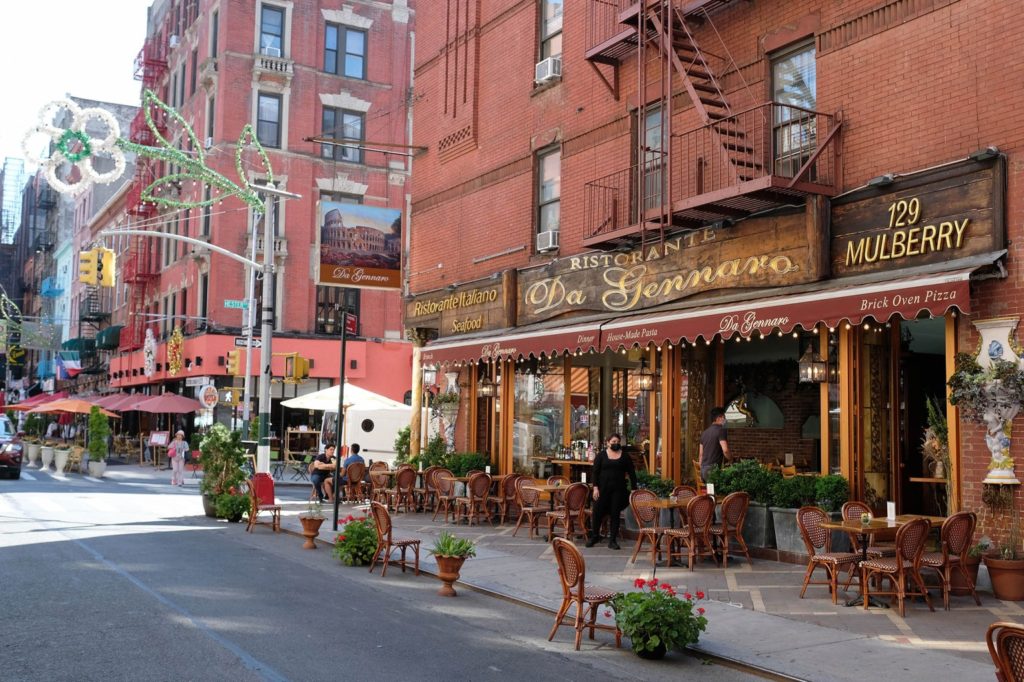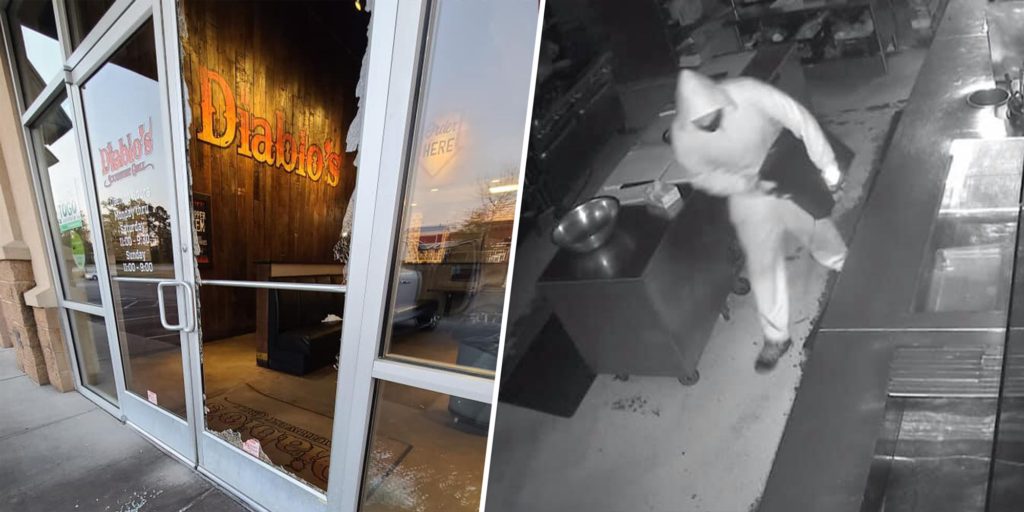纽约市餐饮业开倒车 订座率降六成 业者怪治安
世界新闻网
01/29/2022

根据餐饮订位网站数据显示,与2020年1月相比,纽约市如今的餐厅订座率下降了六成,而疫情爆发两年后,情况没有好转;曼哈顿下城华埠及小意大利商圈业者表示,旅游业仍恢复较慢,很难引入新顾客,加之公共治安恶化,「连本地食客都被吓跑了。」
在线餐饮预定网站OpenTable的此项最新数据,由著名统计学家西尔弗(Nate Silver)进行分析,餐厅及酒吧火热的曼哈顿及布鲁克林订座率与两年前相比,仍分别下降了64%和55%,全市其他三大区的数据尚不清楚。

Dimitrios Kambouris/Getty Images
而平日游客络绎不绝的曼哈顿华埠和小意大利地区下降最为明显,华裔业者表示,节日季刚过人流缓慢下降,且1月开始全市不断发生攻击案件,加之政府换届,所有人都处于预热阶段;「不用暴风雪等恶劣天气加持,生意就已经进入寒冬期了。」
华埠的一些口味值得信赖的餐厅,接到也大多是附近熟客的外卖或外带订单,攻击案件的发生,导致许多人选择待在家里——「游客稀少、办公楼仍空置大半、治安下降使很多食客坐立不安,在公共场合吃饭时人们仍有不同程度的担忧。」

纽约市服务业联盟(NYC Hospitality Alliance)运行总监雷吉(Andrew Rigie)表示,酒吧和餐馆是经济复苏的内核,此行业不振,纽约市很难回温。
他说,仅在纽约市和其他几个大城市实施的疫苗接种规定也是负面影响之一,很多人将活动地点转向了新泽西;而住在布朗士的人可能会去威彻斯特(Westchester County),而皇后区的人可能会去长岛纳苏郡(Nassau County)吃饭。
Restaurant owner offers job to burglar instead of pressing charges
Apr 5, 2021
By WGCL Staff
4/17/2021
AUGUSTA, Ga. (WGCL) – A Georgia business owner caught a thief breaking into his restaurant on surveillance cameras, but instead of getting police involved, he offered the suspect a job.
Just before 4:30 a.m. Saturday, someone broke into Diablo’s Southwest Grill in Augusta, Georgia. The act was caught on surveillance video, whch shows the thief grab the cash register, shake it and, realizing there’s no money inside, take off.
“The suspect threw a brick through the glass [door],” said Carl Wallace, co-founder of the restaurant. “He did more damage to the cost to replace the door than he ever would have gotten out of the register.”
It cost Wallace $1,000 to fix the door. He then wrote a Facebook post about the incident, in which he took the unusual approach of offering the suspect a job.
“To the would be robber who is clearly struggling with life decisions or having money issues… please swing by for a job application. There are better opportunities out there than this path you’ve chosen,” Wallace wrote.
He promised no police would be involved, and he wouldn’t ask any questions.

Wallace says he would like to help the person and offer him a better path. He even went as far as to say he’d be willing to mentor him. He says if the suspect was arrested, he would have a felony on his record and would struggle finding a job.
Wallace says he wants to fix what he calls a broken system and hopes the burglar will take him up on his offer.
“Let’s stop. Let’s fix this. Let’s do something different and give this guy an opportunity,” he said. “I think the follow-up story to this is greater than the initial story.”
美国餐厅遭夜贼行窃,老板竟愿意给他工作
巴西华人网
4/17/2021
美国乔治亚州一家餐厅遭夜贼闯入行窃,该老板不但不恨他,反而愿意提供工作给他,帮他度过难关。此一“以德报怨”的举措赢得了许多网民的称赞。
这家位于乔治亚州奥古斯塔(Augusta)的餐厅在4月3日凌晨4点左右遭一名窃贼入侵。该名窃贼在击碎餐厅的玻璃门之后进入里面行窃。
该餐厅监视器所拍摄的画面显示,这名窃贼疑似一名男子,他在警报声响起后,匆忙将餐厅内的收银机拿走,但餐厅老板华莱士(Carl Wallace)表示,收银机里面是空的,没有放钱。
对此该名窃贼铤而走险的犯罪行径,华莱士以罕见的方式作为回应。他在脸书上发文说,他请对方打电话给他,看看他可以如何提供协助。他愿意提供工作机会给对方,而且不会有警方介入和审讯。
华莱士在脸书的贴文上略述了他的餐厅遭夜贼闯入行窃一事,他还附上了被击碎的玻璃门照片还有监视器拍到的画面。
华莱士告诉CNN说,他一开始对这起事件的反应是“愤怒”和“沮丧”,但随后为该名窃贼感到遗憾。
他说:“你会对他们选择这样的人生道路感到遗憾。你也会想到这个人每次做这种事情给自己带来的危险。”
由于这起闯空门事件正好发生在复活节假期,华莱士认为,以宽恕作为回应似乎是正确的做法。
他说,这好比充当某个人的导师,而对方显然走错了人生道路。
华莱士的贴文受到很多网民的分享与称赞。一名网民留言说,有时候人们会做出不好的决策,但没有人在这起事件中受伤。基于华莱士公开回应这件事,该名网民决定多多光顾他的餐厅,以示支持。
闲聊美国餐饮生意
By 魏习加
4/17/2021
和朋友聊天,他感慨在非洲在越南见到华人开的饮料摊子,一点小心思,一点新花样,一个新包装,都会吸引大批顾客。回想起我在中国的日子里,从农村到城市,都是一样:新东西很容易吸引到消费者。经济在发展,财富在增加,消费群体追新赶时髦,生怕落人之后。反观美国,这个成熟的社会,似乎一直都是那样轻松惬意休闲随意,街头商场的行人稀稀拉拉,常常感觉顾客比店员还要少(就大超市,仓储超市,华人超市人气比较足;快餐店除非是在大城市闹市区或大公司工厂附近的,也是少有排队的景象 – 哦,开车来drive through打包的还是常常要排队的 – 不下车不熄火,突突突突,好不环保,其实也没几辆车,占空)。商场只有节假日期间人才会多一些起来。作为顾客还是挺享受这种被商家珍重的感觉的,但从商家的角度考虑,还真是…有一个比较稀罕的例子,去年附近商场里新开了一个果汁摊,花样新奇,规模不小(约有六七名员工),难得的看到有四五个人在排队等着下单和出单。
亚麻之类的网店,我知道生意是不错的,从各家门口不时出现的各式各样的包裹就能看出来。快递大哥小哥们也总是风风火火的忙,疫情期间更是忙坏了。
Six Spaces Home Staging

Contact: Hongliang Zhang
Tel: 571-474-8885
Email: zhl19740122@gmail.com
说远了。单说餐饮业,美国不光是人口密度难以支撑大的客流量(就是不多不少饿不死的客流,真没客流的也就关门了;就算在纽约华埠的知名馆子,我遇到的,也坐不满),消费习惯更是四平八稳 – 看起来不太会为什么新餐馆新口味新花样而激动 – 当然同事们有时还是会说某处开了新馆子,中午赶着开去吃一顿 – 其实还是没多少人。我们常去的中餐馆里,堂吃和外卖也就那样不多不少的(外卖外送比堂吃是多多了);后厨不是一直在忙,大厨们经常跑出来找我们聊天打趣。以前公司附近的一家泰式餐馆(正宗泰国人开的,口味有点“异国风情”,泰国服务员,不是华人冒充的那种,虽然他们实际上可能还是华裔;很多日式餐馆、寿司店其实都是华人开的,有些装得比较好,客人面前低眉顺眼的轻易不开口,说起英文来细声细气,可偶尔听到他们在门后放声攀谈,哈,还是华人),生意还算很不错了,也就是午饭点上有时能满座。大多数中餐馆,菜品都缺乏变化。有时忍不住跟老板抱怨一下,他们常说的答案就是“洋人不喜欢新花样”(华人顾客比例不大)。我猜也有配送网络的原因 – 多数“美式”社区中餐馆的物流配套估计已经“标准化”了,就那些标准菜品原料。我们以前去的觉得口味手艺比较正宗的中餐馆,一家接一家的关了门,所以估计老板们没有说错,不是他们不愿探索新菜品,真的是因为洋人顾客不喜欢,就难以维持了。洋人不仅对中餐不要求不讲究什么新花样,他们的其它消费习惯也是偏于保守。你可以说他们成熟淡定,不放纵口欲物欲,但客观上,就是缺乏活力的餐饮业。推而广之,我觉得美国并没有多少“消费主义”,虽然据说多数美国人是不喜欢存钱 – 真不知道他们把钱花哪儿去了。或许就是旅游?近来学校春假,孩子的同学朋友们,很多都去旅游了,还是去佛州之类的长途旅游,疫情还没过去呢,照玩不误。也有就近旅游的,但至少也是跨州的(不是跨洲啊)。
疫情期间我们下馆子的钱是真省了不少,只偶尔点过几次外卖。小餐饮业者望眼欲穿的样子,不难想象。
美国人,普通的美国人,好像都不怎么讲究室内装修。千偏一律的厨卫,餐厅那三两样(大桌、高柜,估计通常是家里最贵的家具了)。就算是讲究一点的,厨房电器品牌高档一些,但厨房那些柜子壁橱的材料样式,还是那小样。大多数美国人不好面子,这点让我们觉得挺自在。这是成熟国家的风度,也是商家的活死人墓。新兴经济体有攀比斗富,有以貌取人,有嫌贫爱富,笑贫不笑娼,但那也是商业活力。在美国生活还是挺好的,要赚钱,还是出去(回去)吧。年青人在美国有点浪费了。
Why U.S. Malls Are Disappearing
Mar 4, 2021
Shopping malls in the U.S. were already in decline before the Covid-19 pandemic as consumers shifted away from traditional brick-and-mortar stores to e-commerce. The outbreak has only exacerbated the challenges at malls as social distancing has placed restrictions on stores, movie theaters and restaurants. So what will become of malls in America after the pandemic ends?
Shopping malls across the U.S. have been reeling as restaurant and retail tenants struggle to keep their doors open.
Data compiled by Coresight Research shows about a quarter of U.S. malls could close over the next three to five years, accelerating a trend that began before the pandemic.
Simon Property Group — the nation’s biggest mall owner — said earlier this month that its fourth-quarter revenue dropped by 24% on a year-over-year basis to $1.1 billion.
However, some analysts think Simon — with its portfolio of A-rated malls and a healthy balance sheet — will benefit as distressed malls operated by its rivals close their doors. The company is also expected to see gains from new additions like hotels and luxury residences.
“Unfortunately there are a lot of centers that don’t fit that high profile and that have lost their competitive edge,” said Piper Sandler analyst Alexander Goldfarb. “The thing about Simon is they’ve been really focused on maintaining it, and that’s both been through a combination of culling the lower productive centers as well as making sure that they keep investing in their top centers.”
Simon Property Group CEO David Simon said the company is also getting a lift from increasing traffic at some of its locations and from tenants paying their rent on time.
Malls are a big tax driver for the communities they serve and employ lots of people locally. Watch the video above to find out more about the struggles U.S. malls face and what could become of them after the pandemic ends.
Source: https://www.youtube.com/watch?v=C_JiP-j2FwM
瑞银预测到2026年美国将有8万家门店关闭
北美e生活
4/06/2021
据 CNBC 4月5日 报道,据瑞银(UBS)的一份新报告显示,尽管门店关闭的速度已从2019年的峰值有所放缓,但不要指望这一缓解期会持续太久。该报告显示,美国的人均零售空间仍然太多。
瑞银在使用国际购物中心理事会的数据进行分析时发现,截至去年年底,全美共有11.5万个购物中心,这个数字包括了购物中心、商场、奥特莱斯和其他生活方式中。相比之下,2010年为11.2万个,2000年为9万个。
分析师迈克尔·拉瑟(Michael Lasser)和杰伊·索尔(Jay Sole)解释说,瑞银估计,到2026年,全国约有8万家零售店将关闭,占零售店总数的9%。这假设电商销售额到时上升到占零售总额的27%,而不是现在的18%。
拉瑟在给客户的一份说明中说,“大流行的一个持久作用是,网络普及率急剧上升。我们预计它将继续增加,这将推动零售店的进一步合理化,特别是在政府的一些独特的支持措施消退后”。
尽管越来越多的美国人在网络上的订购从牛奶和面包,到新的办公桌椅,再到运动鞋等各种商品,但开店速度多年来首次超过关店速度。许多商家都在抓住时机,利用更便宜的租金和充足的空置空间进行选择。这一增长主要来自于销售美容、食品杂货和打折商品的零售商,包括Ulta、Dollar General、TJX和Lidl,它们预计流行病后商店的访问量将强劲反弹。
根据Coresight Research整理的数据,今年以来,美国零售商已宣布关闭3169家门店,开店3535家。该公司追踪到2019年有9832家门店关闭,这是它开始跟踪这一数据以来的最高纪录。这一数字在2020年降至8741家。
瑞银预计,零售业最近受到政府刺激措施的支持,以及消费者将资金从服务转移到商品上,旅游和其他娱乐活动因疫情而暂停。但它表示,这些趋势将是短暂的,导致预计的零售销售下滑,这将导致零售关闭的增加。
瑞银预计,未来几年,倒闭最多的将是销售服装和饰品的零售商。该公司预测,到2026年,这一行业将有约21000家店铺关闭,其中许多关闭的店铺位于封闭式购物中心。
瑞银表示,预计家居装修、食品杂货和汽车零部件零售业的关店数量将最为有限,因为这些品类不太容易受到电商崛起的伤害。
The death of the department store and the American middle class
The collapse of America’s middle class crushed department stores. Amazon and the pandemic are the final blows.
By Jason Del Rey
11/30/2020
In a New Jersey suburb seven miles west of Midtown Manhattan, the American Dream is on shaky ground.
The Dream in question isn’t the mythological notion that upward social mobility is within reach for all hardworking Americans. It’s a $5 billion, 3 million-square-foot shopping and entertainment complex in East Rutherford featuring an indoor ski slope, an ice-skating rink, and a Nickelodeon-branded amusement park. The complex finally opened last fall, but it’s now facing huge new challenges.
The development’s complicated 17-year history, marked by ownership changes, false starts, and broken promises, had already put American Dream in a precarious situation. The Covid-19 pandemic hitting in March made things much worse. Whether the mall makes it in the long term will hinge in part on how it deals with the collapse of three of the marquee department stores that were to anchor the complex and draw foot traffic — Barneys New York, Lord & Taylor, and Century 21 — which all have gone bankrupt and closed, or are planning to close all their stores in the US.
Around 100 storefronts in American Dream opened their doors to customers in October and November, but the complex’s future is not guaranteed. Its owners, Triple Five Group, missed several mortgage payments this summer, and it’s not clear who might fill the enormous holes left by the three fallen department store chains, or which other retail tenants will opt out of their leases now that the development is missing three of its anchors.
While the story of American Dream is unique in many ways, its struggles are emblematic of the bleak future facing many US malls and department stores — whose destinies have long been intertwined. The downfall of these onetime crown jewels of retail will have meaningful impacts on the Americans who work for them and the communities they’ve long called home.
Across the US, department stores are shrinking or shuttering altogether. In 2011, US department stores employed 1.2 million employees across 8,600 stores, according to estimates from the research firm IBISWorld. But in 2020, there are now fewer than 700,000 employees in the sector, working across just over 6,000 locations.
:no_upscale()/cdn.vox-cdn.com/uploads/chorus_asset/file/22130979/GettyImages_1178102058.jpg) The American Dream megamall in East Rutherford, New Jersey, was under development for 17 years before opening in late 2019. Timothy A. Clary/AFP via Getty Images
The American Dream megamall in East Rutherford, New Jersey, was under development for 17 years before opening in late 2019. Timothy A. Clary/AFP via Getty Images
The reasons for the struggles are both shared and unique. Since the Great Recession began in late 2007, the vast majority of income growth in the US has gone to high-income households, squeezing middle-class households and altering where they spend money. As a result, chains that sell brands at sharp discounts like TJ Maxx, Ross, and Dollar General have become more popular, siphoning away shoppers from full-price department stores like Macy’s and J.C. Penney that were designed to cater to a stronger middle class of yesteryear.
Department stores are also facing the reality that they are no longer the main way most shoppers discover or access new brands — which was once perhaps their main appeal as onetime innovators. Consumer brands have increasingly become focused on building connections with customers through their own stores, websites, social media platforms, and other online-only marketplaces.
All the while, department stores’ contraction is upending local labor markets and the communities they called home. And rock bottom is not even here yet. More than half of all mall-based department stores will close by the end of 2021, according to estimates by Green Street Advisors, a commercial property research firm. And that will have a massive impact on malls; as of January, department stores accounted for nearly one out of every three square feet in malls.
“The department store genre has been taking the great American shopping mall down with it, slowly but inevitably,” said Mark Cohen, the director of retail studies at Columbia University who was previously the CEO of multiple department store chains in the US and Canada.

What happens when an entire sector of retail, one that employs more than half a million people, is in free fall — and is slowing or dragging down shopping malls like American Dream with it? And what becomes of the local communities across the country whose social identities and local economies rested on, at least in part, now-fallen department stores and the malls they buttressed? We’re about to find out.
What’s killing the department store
For much of the past century, US department store chains played an important role in many Americans’ lives and an innovative role in the retail sector.
For the American middle class of the 20th century, department stores helped shape what successfully living the American dream looked like. These stores were often an entry point into fashion and home furnishing trends once reserved for only the wealthiest, since they offered large selections of name brands at affordable prices all under one roof — first in big cities, and then following population exoduses to the suburbs. And as the main attractions for malls in the suburban US, they played a foundational role in the idea of shopping as a social activity in the second half of the 20th century.
Department store employees also had it pretty good, for a time. The sector was welcoming to women salespeople, providing a path to certain corporate roles for those who found success, according to the book From Main Street to Mall: The Rise and Fall of the American Department Store. A successful salesperson working in one of these stores, especially before large chains came to dominate the sector, could make a career of their role, providing for their family, no college degree needed. Those days are mostly long gone.
But over the past two decades, a confluence of other factors has placed several giants at death’s door and put even the most innovative in a precarious situation. These factors were both external and internal: Amazon led a boom in online shopping, and many brands that once relied on department stores began selling directly to customers online and in their own stores. Meanwhile, many department store chains made the wrong bets, investing more heavily in store expansion while underinvesting in merchandise differentiation and e-commerce strategies.
But perhaps most critically for the chains targeting the middle class — think Macy’s, J.C. Penney, and Bon-Ton — this category of households has been struggling since the Great Recession began in 2007. According to a 2018 study from the consulting firm Deloitte, “the middle 40 percent” of the country saw its income shrink in the previous decade, while more than $8 out of every $10 in income growth nationwide went to high-income households. As a result, discount chains that sell name brands at a bargain — like TJ Maxx and Ross stores — became much more attractive to middle-class shoppers than department stores selling at full price. The treasure-hunting aspect of stores like TJ Maxx and Home Goods also added to their appeal over many of their department store competitors. Macy’s, the largest traditional department store in the country, said earlier this year that it planned to close 125 of its 800-plus stores — and that was before the pandemic.
“Sears was built for [the] middle-class mall goer,” Web Smith, the founder of the commerce and media newsletter 2PM, wrote in the wake of Sears’s 2018 bankruptcy. “It’s been the thesis of 2PM, Inc. that retailers who’ve built their businesses for this American demo will continue to struggle until the American middle class rebounds.”
But department stores catering to wealthier customers have failed, too. In addition to Sears and J.C. Penney, higher-end stores Barneys New York, Lord & Taylor, and Neiman Marcus have all filed for bankruptcy in the past two years. Even Nordstrom, viewed by industry insiders as the most progressive traditional department store chain, is facing significant headwinds. While overall US e-commerce sales increased 45 percent year over year from April to June as pandemic shutdowns pushed more shoppers online, Nordstrom registered just 20 percent growth in online sales.

As more Americans came online and as social media platforms rose in popularity, brands started establishing direct relationships online and through their own stores, which chipped away at their reliance on department stores for finding customers. For a while, department stores still could provide a way to reach mostly older consumers who preferred in-person shopping or others who didn’t have internet access, but the chains became more complementary for popular brands rather than remaining a crucial sales channel.
More mid-priced brands such as Levi’s and Adidas started selling on Amazon and other online marketplaces as department stores targeting the middle class began to struggle, meaning chains like Macy’s now had serious online competition, too. And since Amazon and other top online retailers are in many cases more convenient than visiting a large store where salespeople are trained and paid less than they once were, department store advantages further diminished.
:no_upscale()/cdn.vox-cdn.com/uploads/chorus_asset/file/22130344/GettyImages_900421204.jpg) Two of the three anchors at the Shenango Valley Mall in Hermitage, Pennsylvania, have closed in recent years. Dustin Franz for The Washington Post via Getty Images
Two of the three anchors at the Shenango Valley Mall in Hermitage, Pennsylvania, have closed in recent years. Dustin Franz for The Washington Post via Getty Images
Finally, some private equity companies — investment firms that buy up struggling companies in part by saddling them with debt — have taken aim at the sector, and the debt associated with their takeovers has hastened the demise of some department store chains like Neiman Marcus. The Dallas-based luxury chain filed for bankruptcy earlier this year under crushing debt from its PE owner.
The chain was also late to e-commerce — when it finally started getting aggressivearound 2014, introducing free shipping and returns to better compete with Nordstrom, it didn’t work and instead crimped its profits. The company’s bottom line was also hurt by some of the biggest brands it sells moving from a wholesale model to a more flexible and lower-risk model that was less profitable for Neiman Marcus. While a private equity owner didn’t force these moves, the fallout from these crises coupled with a heavy debt burden was a recipe for disaster.

How the decline of department stores is reshaping communities
While the pandemic has accelerated contraction of the department store industry, the sector has been in a slow descent for decades. And the communities they call home, which experienced the upside of their presence during the golden years, are now faced with a series of cascading challenges.
“First they become an eyesore; it’s aesthetically damaging,” said Vicki Howard, the author of From Main Street to Mall. “Second, there’s the jobs. … Third, it impacts the consumers themselves that have turned to that area for leisure activities, for places to go in the winter, to go with their kids.”
“It’s quite a big economic and social and cultural phenomenon to have these department stores closing — and malls also,” she added. “They occupy such a physical place as well as a social space.”
The decline of department stores and the malls they supported has required local governments to get creative. In Bartlesville, Oklahoma, a city of 36,000 near the border of Kansas, local officials have embraced discount chains as the local Washington Park Mall has struggled. The city provided $1.5 million in incentives in 2016 to develop an outdoor shopping center with popular discount retailers TJ Maxx and Ross to help offset the longtime troubles of the mall, once anchored by the department stores Sears, J.C. Penney, and Dillard’s. (Sears and J.C. Penney both closed their stores there in recent years, and Dillard’s recently turned its mall location into a clearance store.)
“We’ve been exceedingly fortunate to have replaced the mall’s legacy brands with up-and-coming brands better aligned with today’s consumer preferences,” David Wood, Bartlesville’s economic development chief, told Recode in an email.
The city also provided a $200,000 incentive to divide an old Kmart into five smaller retail establishments, including outlet stores Ollie’s and Burkes Outlet, as well as a Dollar Tree store. The new retail additions, Wood added, “have largely offset the employment loss — with rising sales tax collections, too.” Taxable physical retail sales dropped in 2015 and 2016 in Bartlesville but grew modestly in 2018 and 2019. Of course, department store jobs are different from discount chain jobs, which have lower average hourly pay and rarely offer sales commissions.
In Madison, Wisconsin, local city-planning officials are looking ahead to a possible future where their city won’t have malls anchored by department stores. They have been discussing potential redevelopment plans for the areas around the community’s struggling East Towne Mall and West Towne Mall since 2018, and the discussions took on added significance when the malls’ owner filed for bankruptcy in early November.
Several of the malls’ anchor tenants have closed up shop in the past few years, including the department store chains Boston Store and Sears. While the Madison economy is diverse outside of retail, with a large research university and state government offices calling the city home, city planners believe it is critical to start discussing potential redevelopment plans, whether or not the mall’s owner ends up selling or gets on board with redevelopment, because by the time large commercial properties are in true distress, the ripple effects can be dangerous.
“Longer-term vacancies can sometimes snowball and have the effect of spreading and negatively impacting surrounding areas,” said Ben Zeller, a city planner for Madison.
:no_upscale()/cdn.vox-cdn.com/uploads/chorus_asset/file/22130781/GettyImages_827823162.jpg) Display tables and a mannequin sit for sale on the empty floor of a former J.C. Penney store at the Columbia Mall in Bloomsburg, Pennsylvania. Don Emmert/AFP via Getty Images
Display tables and a mannequin sit for sale on the empty floor of a former J.C. Penney store at the Columbia Mall in Bloomsburg, Pennsylvania. Don Emmert/AFP via Getty Images
Madison officials have been studying other mall redevelopment plans around the country for ideas about what to do. If redevelopment of these Madison malls does end up happening and looks anything like projects in other communities that city planners are studying, the retail presence would likely be downsized and supplemented by new residential buildings and non-retail employers. Zeller himself lives in an apartment building built on a former mall parking lot in another part of Madison.
At a high level, Zeller told Recode that such redevelopment plans are complex, which means they take time: 15 to 20 years or longer to complete. One challenge involves the fragmented ownership structure of large mall properties, where the main mall may be owned by one business and the department store anchors and restaurants could be owned by separate entities. Another challenge involves restructuring the public street network around malls.
“It’s very difficult to have a future neighborhood created when there are blocks [in existing mall developments] that are 100 to 200 acres as opposed to a normal city block,” he added. Residential neighborhoods typically need shorter street connections to make public transportation and walking viable.
Zeller added that the city wants to make sure that, no matter who buys in, “we ultimately end up with a connected public street network, adequate parkland to serve new residential uses, integrated transit, an improved bike network, and other components of complete neighborhoods.”
In short, communities can rebound from department store chain failures — and the ripple effect on malls — if they have the time and resources to plan two decades into the future like Madison is starting to. But not every American community does.
What it means for the people who depend on retail jobs
While some of the evolution that the department store sector has gone through marked natural generational shifts in consumer behavior, the industry’s failures have had a significant impact for those who work in retail, extinguishing the idea of retail sales positions as careers — whichin the 20th century was an advantage for department stores.
“It’s a negative cycle. If you have less career-oriented employees and higher turnover, you invest less in those employees,” said Jason Goldberg, the chief commerce strategy officer at the global advertising holding company Publicis. “It creates this vicious cycle and then you can’t recruit good employees. They were turned from advisers and very relationship-based salespeople into cashiers.”
With few exceptions, the idea of a department store sales job being a career hasn’t been a reality for decades. In the mid-1900s, they could be steady, family-supporting jobs with fixed schedules. But in the decades following the birth of big-box retailers Walmart, Kmart, and Target — all in 1962 — retail wages began dropping as traditional chains chased the lower-paying labor models of the new discount retailers.
“I would have to guess that by 1980 it was not likely that a single-wage earner could support a family while working on the selling floor of a retail store,” said Cohen, the Columbia professor and former department store executive.
Yes, there are still top salespeople at chains like Nordstrom or Neiman Marcus who might pull in six figures, but they are the few exceptions to the rule.
So where are department store employees going as their employers cut jobs, close stores, or go bankrupt?In the five-year period from 2015 to 2019, more started working in discount chains. The category of the retail industry that includes dollar stores like Dollar General jumped into the top five categories of employment that attracted workers who had recently left or were laid off from a department store job. (This job transition data was based on a Brookings Institution analysis of current population survey public-use microdata provided to Recode by Chad Shearer, a former senior research associate at the think tank who is now an economic development consultant.)
That may not be a great thing, as least as it relates to employee earnings. While Dollar General’s stock price has nearly tripled over the past five years, its front-line employees don’t see much of that enrichment. Average hourly base pay at Dollar General is $9, according to the job review site Glassdoor, compared to $11 at Macy’s.
The rise of e-commerce can be seen in this job movement data, too.During the same five-year period, if you combine the “electronic shopping” and “warehousing” job sectors (which both include e-commerce companies) into one category of employment, the combined sector moves into the top 10 for industries where employees who had recently left department store roles went to work next. It’s possible e-commerce employers should rank even higher in reality, since many e-commerce warehouse employees are technically hired by third-party temporary employment firms.
:no_upscale()/cdn.vox-cdn.com/uploads/chorus_asset/file/22130805/GettyImages_1136921937.jpg)
There are trade-offs to this shift. On the one hand, Amazon warehouse employees in the US make a base wage of $15 an hour, which is a higher base pay than most entry-level department store jobs. But the work is often much more physical in nature than a retail job,requiring workers to pick or stow hundreds of items per hour at a rapid pace and to be able to lift up to 50 pounds of goods. The reality is that when it comes to finding a job in 2020, Amazon and Walmart — already the two biggest private sector employers in the US — are the retailers offering work. While so many industries have contracted, they’ve added hundreds of thousands of new job openings this year alone. And as department stores continue to cut jobs, the largest players in the new retail economy capture more power in the labor market.
How to rebuild from department stores’ ruins
There is no silver bullet for US department stores to immediately start thriving again, so the best many can do is simply try to adapt and survive. For chains that still have a nationwide presence — like Macy’s or Nordstrom — that means fewer large, full-price stores and more investment in e-commerce sales, potentially supplemented by smaller pickup points for online orders to offset expensive shipping costs. Macy’s executives have also said the company plans to test smaller stores that aren’t attached to malls in an effort to unhitch their destiny from struggling regional malls built for a weakening American middle class.
As these chains fight their uphill battles, they are being replaced by a bevy of options that can provide better prices, selection, or convenience to shoppers of all wealth levels. The best discount chains, for example, are still thriving a decade after the Great Recession ended. Even without a strong e-commerce presence, the parent company of TJ Maxx, Marshalls, and Home Goods is moving steadily through the pandemic, with a stock price equal to what it was before Covid-19 hit the US in March. And Dollar General’s stock price hit an all-time high in October; the company is now worth nearly $53 billion.
Brands that sell apparel and cosmetics — key product categories for many department store chains — continue to sell more goods directly to shoppers through their own stores and websites rather than through department store chains. This direct connection gives brands, whether they’re established or new startups, more control over how their goods are displayed, more information about who their customers are, and often better profit margins. Nike, for example, stopped selling through department stores Belk and Dillard’s earlier this year and is no longer available at the online retailer Zappos. Under Armour announced it would cut its wholesale partners in North America by 2,000 to 3,000 stores. New online retailers that attract digital-savvy consumers and, in turn, more brands — like Stitch Fix, Rent the Runway, The RealReal, and ThredUp — were also stealing market share from department stores pre-pandemic.
But Amazon continues to be the titan of the modern retail world. It’s at least seven times bigger than No. 2 Walmart in e-commerce, and it’s continuing to invest in beefing up its physical store presence as well. While the online giant’s direct impact on department stores was minimal for much of its history, things have changed in recent years. Amazon is still not a high-end fashion destination, but it is absolutely a place where a majority of Americans are willing to buy footwear, casual clothing, or basics like underwear and socks. In April, the retail research firm Coresight said that more than 70 percent of apparel shoppers bought clothing or footwear on Amazon in the prior 12 months — an increase of 10 percentage points from 2019 and 25 percentage points from 2018. At the weakest moment for department stores, Amazon is becoming a more powerful direct competitor.
Taken together, the future for department stores is bleak, and for many of the malls they anchor. Yes, the US has too many retail stores — 40 percent more retail square feet per person than No. 2 Canada — and too many subpar malls, considering current shopping trends. Yes, the retailers courting business away from department stores are providing superior products, prices, or experiences that are resonating better with shoppers. Yes, it is normal in capitalism for industry categories to fall while others rise.
But the communities across the country that depended on these stores and malls as job creators will have to get creative to rebuild around their ruins. And the Americans who once saw a department store sales job as a potential career, or at least an entry path to a better-paying retail corporate job, now face a new reality: Many of the biggest retailers hiring today — discount chains and e-commerce giants — are offering less pay, or perhaps better pay but less personable and more grueling work.
Even if you could snap your fingers and return this retail sector to glory, it wouldn’t solve the key societal and macroeconomic problems connected to its decline. While the median US household brought in 48 percent more income in 2018 than in 1970, the vast majority of those gains happened prior to 2000. Along the way, the middle class’s income share — which many of the biggest department store chains catered to — has shrunk by 19 percentage points as the rich keep getting richer. In turn, most shoppers value discounts above all else; who can blame them? And for those who can afford it, the convenience of Amazon Prime delivery and its endless virtual shelves of merchandise is very difficult to beat. If the American dream of department stores wasn’t fully extinguished before 2020, the year of the pandemic will make sure it is.
Source: https://www.vox.com/recode/21717536/department-store-middle-class-amazon-online-shopping-covid-19









